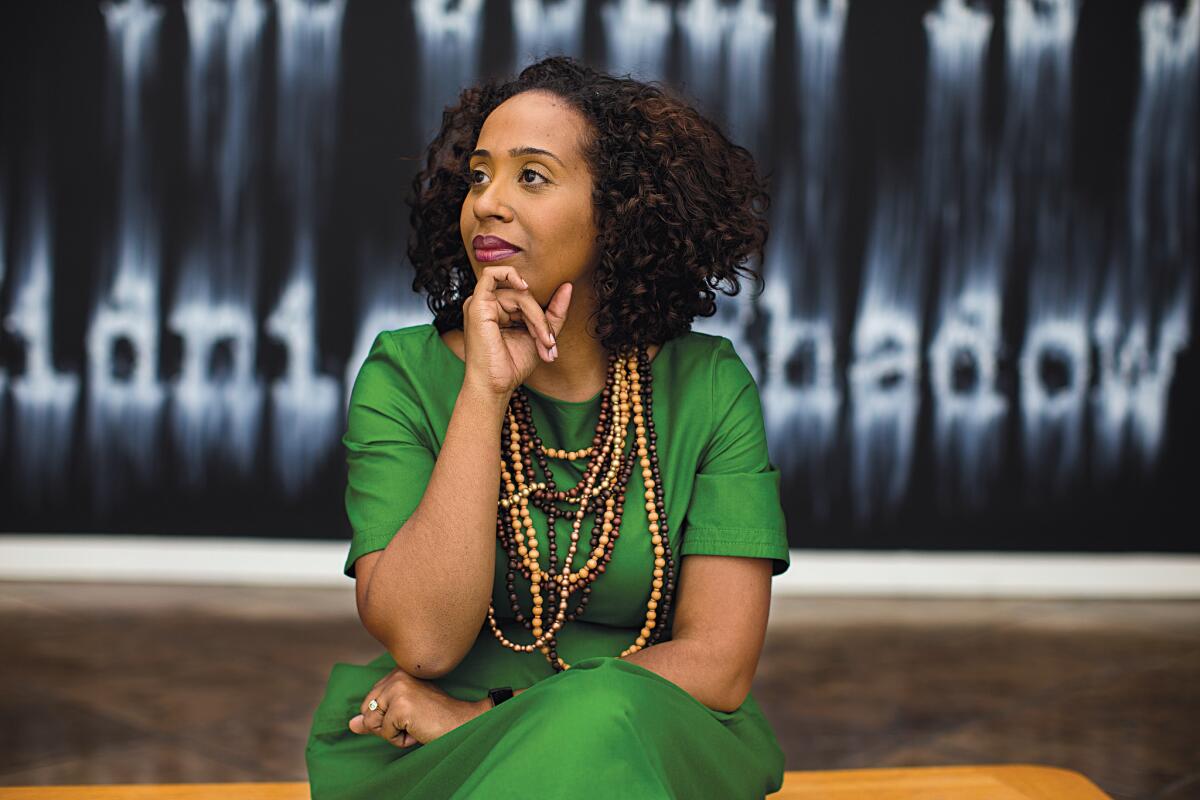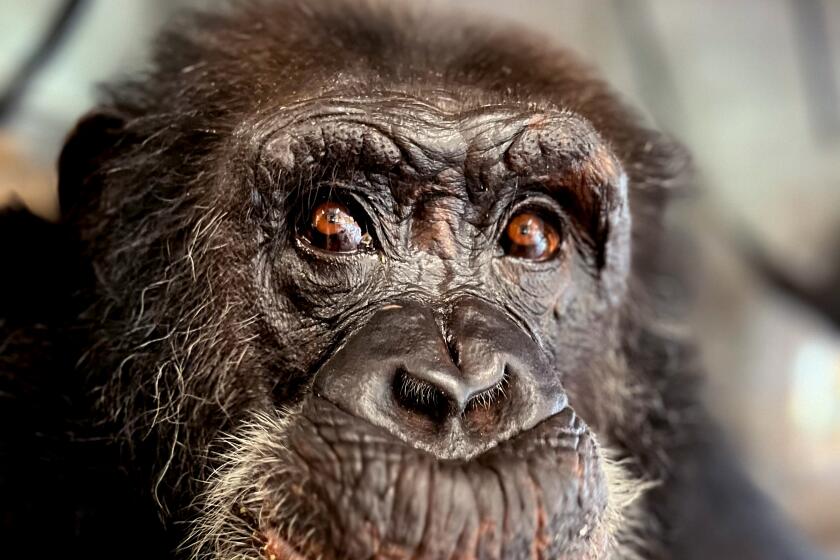Naima Keith’s Electric Vision: Giving the California African American Museum a Jolt of Energy

On a recent July evening more than two thousand people circulated at an unusually vibrant art-world party in Exposition Park. It was the summer season debut at the California African American Museum (CAAM), with four new exhibitions opening at once. Guests streamed through the freshly painted galleries, food trucks doled out steaming bowls of jambalaya and spiced catfish nuggets, and DJs spun a mix of hip hop, soul and R&B. Then came the electric slide.
Dozens of guests spontaneously coalesced, forming rows of dancers in the museum’s atrium, and soon they were side-stepping to the song “Electric Boogie.” All the while Naima Keith, the museum’s new deputy director and chief curator, worked the crowd in a multicolored silk kimono and patent-leather sneakers, ping-ponging between artists, lenders, museum directors and city officials as the line dance spread outdoors to the courtyard. “It was just this moment—I looked around and, wow, this is what we were hoping for, this is what we wanted to create,” says Keith. The 1980s dance marked a turning point for the formerly sleepy museum, and it was an appropriate one at that. Because if there’s one thing Keith—a nationally known curator with a background in contemporary art—has infused in CAAM since taking her post about a year and a half ago, it is electricity.
Only two years ago CAAM was a small state-funded museum that had been present- ing worthy exhibitions since the 1980s but still had a low profile in the city. That it had been without a permanent director for about a year didn’t help. One of the first things interim-director George Davis did was reach out to Keith, an L.A. native who was working as an associate curator at the Studio Museum in Harlem. Davis, now executive director of CAAM, steers the museum’s business operations; Keith oversees exhibitions and public programming. Her passion for contemporary art along with her commitment to emerging artists of color, particularly L.A. artists, has injected the museum with new vitality and rallied the local art world.
In the same way that the Studio Museum helped fuse and elevate a marginalized community of African-American artists in New York when it opened in the late 1960s, CAAM is bringing together artists of color in L.A. Through the museum and lecture series like “Activism Now,” Keith has created a physical space for dialogue around issues of art, activism and diversity—a particularly important role given the current political climate, when funding for the arts is at risk and issues of diversity are roiling through the national conversation.
“The conversation has widened and evolved since 1968, and there are more artists of color showing in museums,” says Keith. “We’ve made strides, but I don’t think the art world is anywhere near equitable in museums and galleries. Our work isn’t done in terms of bringing greater awareness to artists of color—we have a long way to go.”
Hammer Museum director Ann Philbin calls Keith a visionary. “Naima has fostered a new creative energy at CAAM that holds contemporary art at the forefront,” Philbin says. “CAAM is really flourishing into what the Studio Museum has been for Harlem and beyond, in that its exhibitions and programs are building community and bringing forth critical conversations. I’m excited to witness the legacy Naima builds moving forward.”
The administrative halls of CAAM are austere and somewhat institutional-looking. But when Keith opens her own office door, it reveals a space that’s bursting with color, warm and inviting —“more like me,” she says. In a tailored pink dress, she’s at once authoritative and accessible, her conversation punctuated by thoughtful pauses and quick smiles. Behind her, photographs line a shelf: Keith’s two-year-old daughter, Ella, by a vintage photograph of the child’s namesake, Ella Fitzgerald; eight-year-old Keith with her sister and mother before their first Michael Jackson concert; prints by an artist she discovered on Instagram.
Managing a “mission-specific museum,” as Keith calls it, is a tricky dance. “Our mission allows us to focus on a particular group of people, but the goal is to show them in a way that has relevance to a wider public,” she says. Keith has been visiting CAAM since she was a child and has deep respect for the museum’s founders, she says—including long-time director Charmaine Jefferson, who retired in 2014—so she’s reticent on the topic of reinventing the museum’s mission. Instead, Keith says, she’s building upon it.
“I want to honor the original mission of supporting artists of African-American descent and producing exhibitions that focus on the West, typically California,” she says. “But there was a time when exhibitions were these grand, ‘three-hundred-years-of-history-in-three-thousand-square-feet’ kinds of things. I want to do more focused exhibitions that anchor us in a particular time period or idea.” Supporting more emerging contemporary artists is also central to the mission. “There’s a real opportunity for CAAM to support artists of color very early on that I’m not sure other museums are doing with the same regularity.”
In her first two seasons at CAAM, Keith gave exhibitions to emerging California artists Genevieve Gaignard and Kenyatta A. C. Hinkle. CAAM’s “No Justice, No Peace: LA 1992” show this summer offered decades of socio-political context leading up to the 1992 Los Angeles uprisings, while “Center Stage,” which closes on October 15, provides a nuanced exploration of African-American representation in cinema through the lens of female protagonists in silent race films. And Keith commissioned a massive lobby installation by Gary Simmons—five floor-to-ceil- ing text-based murals—that’s edgy, hip and uber-contemporary.
“Naima is pushing boundaries here,” says Simmons. “She’s trying to bring in a certain contemporary art element, installation work that’s not in frames or scaled typically for the setting. I think she wants to challenge some of those conventions. It gives us, as artists, a kind of freedom.”
The museum has also gotten a facelift. Shortly after Keith arrived, the free museum—which receives about $3 million a year in state fund- ing and has a nonprofit fundraising arm—had just gotten $2 million in deferred-maintenance funds from the state of California. She and Davis had the CAAM logo redesigned and a new website built, and they painted the museum exterior a bright white. Though its membership is still low (roughly 1,300), CAAM is now reaching a decidedly younger audience on social media, and annual visits have doubled under her tenure.
Keith and her husband, Eduardo Soriano-Hewitt, a policy advisor for Mayor
Still, art was never a career goal for Keith. She excelled at math and always thought she’d go into business. But an art history class at Spelman College changed her course. Dur- ing graduate school at UCLA, she interned all over the city—at
Three years as a curatorial fellow at the Hammer Museum after grad school, where she worked on the exhibition “Now Dig This! Art and Black Los Angeles 1960-1980,” still makes her speech quicken with excitement. “It changed my life,” she says, “getting an opportunity to work with Kellie Jones and artists I’ve known or respected my entire life.” Even at the Studio Museum, Keith was committed to the L.A. art scene, curating exhibitions there by seminal L.A. artists, including “Rodney McMillian: Views of Main Street” and “Charles Gaines: Gridwork 1974-1989.” The latter was nominated for Best Monographic Museum Show in New York by the International Association of Art Critics.
At CAAM, Keith is aiming to highlight the museum’s 4,000-object permanent collection, creating exhibitions that connect the dots between under-recognized artists from the 1960s and 1970s and the more contemporary work that’s grown out of it. She also plans to showcase not just California artists but artists inspired by California as a subject. “My hope, ultimately, is to surprise, complicate, inspire one’s understanding of African -American art,” she says.
This fall the museum is presenting “We Want a Revolution,” a two-gallery exhibition with a feminist bent, focusing on African-American women artists from the 1960s and 1970s (it’s traveling from the Brooklyn Museum and opens here October 13). For the Getty’s Pacific Standard Time: LA/LA, it partnered with the Chinese American Museum on an exhibition looking at the Chinese presence in the Caribbean, “Circles and Circuits,” which opened on September 15. On her wish list: “I’d love to do a major exhibition on Paul R. Williams, the architect. And I’ve been egging my history curator to do an exhibition on Compton—from farmland to N.W.A fame.”
Sitting in her office, recalling the recent summer party, Keith breaks into a smile. The evening encapsulated so much of what the museum is going for: diversity, relevance, accessibility—and, yes, electricity. “It was less about it being a party and more about seeing CAAM as a place people feel welcome,” Keith says. “There were older people, younger people, white, black, Asian, Latino. People saw it as this destination to enjoy art history and culture. People felt at home.” Then she chuckles: “Basically, we wanted people to feel comfortable enough to do the electric slide in the museum!”
CAAM, 600 State Dr, Los Angeles, CA 90037
The biggest entertainment stories
Get our big stories about Hollywood, film, television, music, arts, culture and more right in your inbox as soon as they publish.
You may occasionally receive promotional content from the Los Angeles Times.








